Case-Based Reasoning for the Design of Micro-Electro-Mechanical Systems
中国计算机学会推荐国际学术会议和期刊目录AB
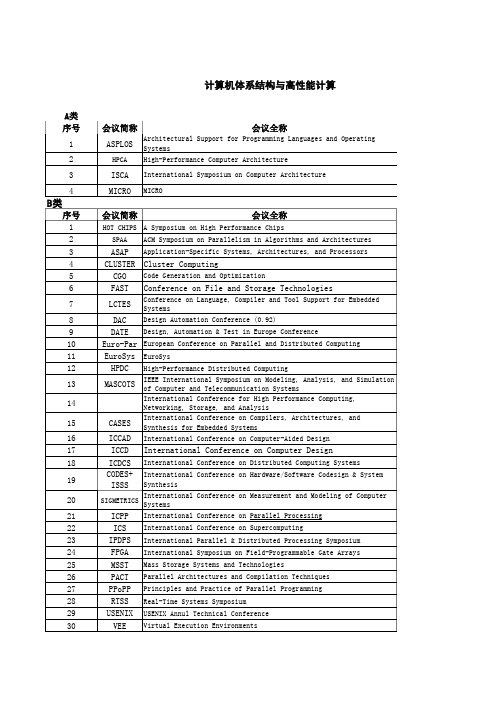
IFIP International Conferences on Networking
International Conference on Network Protocols International Conference on Pervasive Computing and Communications Internet Measurement Conference International Symposium on Mobile Ad Hoc Networking and Computing International Workshop on Quality of Service
3 4 5 6
Eurocrypt
ESORICS CSFW RAID
7 8 9 10 11
NDSS DSN
ISOC Network and Distributed System Security Symposium The International Conference on Dependable Systems and Networks Theory of Cryptography Conference USENIX Security Symposium Workshop on Information Hiding
Annual Computer Security Applications Conference
CRYPTO 会议简称
ACSAC
B类
序号 1
2
ASIACRYPT
Annual International Conference on the Theory and Application of Cryptology and Information Security Annual International Conference on the Theory and Applications of Cryptographic Techniques European Symposium on Research in Computer Security IEEE Computer Security Foundations Workshop International Symposium on Recent Advances in Intrusion Detection
剑桥雅思阅读5test2翻译及答案

剑桥雅思阅读5test2翻译及答案雅思阅读是块难啃的硬骨头,需要我们做更多的题目才能得心应手。
下面小编给大家分享一下剑桥雅思阅读5test2原文翻译及答案解析,希望可以帮助到大家。
剑桥雅思阅读5原文(test2)READING PASSAGE 1You should spend about 20 minutes on Questions 1-13, which are based on Reading Passage 1 below.BAKELITEThe birth of modern plasticsIn 1907, Leo Hendrick Baekeland, a Belgian scientist working in New York, discovered and patented a revolutionary new synthetic material. His invention, which he named ‘Bakelite,’was of enormous technological importance, and effectively launched the modern plastics industry.The term ‘plastic’ comes from the Greek plassein, meaning ‘to mould’. Some plastics are derived from natural sources, some are semi-synthetic (the result of chemical action on a natural substance), and some are entirely synthetic, that is, chemically engineered from the constituents of coal or oil. Some are ‘thermoplastic’, which means that, like candlewax, they melt when heated and can then be reshaped. Others are ‘thermosetting’: like eggs, they cannot revert to their original viscous state, and their shape is thus fixed for ever. Bakelite had the distinction of being the first totally synthetic thermosetting plastic.The history of today’s plastics begins wit h the discovery of a series of semi-synthetic thermoplastic materials in the mid-nineteenth century. The impetus behind the development ofthese early plastics was generated by a number of factors —immense technological progress in the domain of chemistry, coupled with wider cultural changes, and the pragmatic need to find acceptable substitutes for dwindling supplies of ‘luxury’ materials such as tortoiseshell and ivory.Baekeland’s interest in plastics began in 1885 when, as a young chemistry student in Belgium, he embarked on research into phenolic resins, the group of sticky substances produced when phenol (carbolic acid) combines with an aldehyde (a volatile fluid similar to alcohol). He soon abandoned the subject, however, only returning to it some years later. By 1905 he was a wealthy New Yorker, having recently made his fortune with the invention of a new photographic paper. While Baekeland had been busily amassing dollars, some advances had been made in the development of plastics. The years 1899 and 1900 had seen the patenting of the first semi-synthetic thermosetting material that could be manufactured on an industrial scale. In purely scientific terms, Baekeland’s major contribution to the field is not so much the actual discovery of the material to which he gave his name, but rather the method by which a reaction between phenol and formaldehyde could be controlled, thus making possible its preparation on a commercial basis. On 13 July 1907, Baekeland took out his famous patent describing this preparation, the essential features of which are still in use today.The original patent outlined a three-stage process, in which phenol and formaldehyde (from wood or coal) were initially combined under vacuum inside a large egg-shaped kettle. The result was a resin known as Novalak which became soluble and malleable when heated. The resin was allowed to cool in shallow trays until it hardened, and then broken up and ground intopowder. Other substances were then introduced: including fillers, such as woodflour, asbestos or cotton, which increase strength and moisture resistance, catalysts (substances to speed up the reaction between two chemicals without joining to either) and hexa, a compound of ammonia and formaldehyde which supplied the additional formaldehyde necessary to form a thermosetting resin. This resin was then left to cool and harden, and ground up a second time. The resulting granular powder was raw Bakelite, ready to be made into a vast range of manufactured objects. In the last stage, the heated Bakelite was poured into a hollow mould of the required shape and subjected to extreme heat and pressure, thereby ‘setting’ its form for life.The design of Bakelite objects, everything from earrings to television sets, was governed to a large extent by the technical requirements of the molding process. The object could not be designed so that it was locked into the mould and therefore difficult to extract. A common general rule was that objects should taper towards the deepest part of the mould, and if necessary the product was molded in separate pieces. Moulds had to be carefully designed so that the molten Bakelite would flow evenly and completely into the mould. Sharp corners proved impractical and were thus avoided, giving rise to the smooth, ‘streamlined’ style popular in the 1930s. The thickness of the walls of the mould was also crucial: thick walls took longer to cool and harden, a factor which had to be considered by the designer in order to make the most efficient use of machines.Baekeland’s inve ntion, although treated with disdain in its early years, went on to enjoy an unparalleled popularity which lasted throughout the first half of the twentieth century. It became the wonder product of the new world of industrialsexpansion —‘the material of a thousand uses’. Being both non-porous and heat-resistant, Bakelite kitchen goods were promoted as being germ-free and sterilisable. Electrical manufacturers seized on its insulating properties, and consumers everywhere relished its dazzling array of shades, delighted that they were now, at last, no longer restricted to the wood tones and drab browns of the preplastic era. It then fell from favour again during the 1950s, and was despised and destroyed in vast quantities. Recently, however, it has been experiencing something of a renaissance, with renewed demand for original Bakelite objects in the collectors’ marketplace, and museums, societies and dedicated individuals once again appreciating the style and originality of this innovative material.Questions 1-3Complete the summary.Choose ONE WORD ONLY from the passage for each answer.Write your answers in boxes 1-3 on your answer sheet.Some plastics behave in a similar way to 1……… in that they melt under heat and can be moulded into new forms. Bakelite was unique because it was the first material to be both entirely 2……… in origin, and thermosetting.There were several reasons for the research into plastics in the nineteenth century, among them the great advances that had been made in the field of 3…………a nd the search for alternatives to natural resources like ivory.Questions 4-8Complete the flow-chart.Choose ONE WORD ONLY from the passage for each answer.Write your answers in boxes 4-8 on your answer sheet.The Production of Bakelite图片6Questions 9 and 10Choose TWO letters A-E.Write your answers in boxes 9 and 10 on your answer sheet.NB Your answers may be given in either order.Which TWO of the following factors influencing the design of Bakelite objects are mentioned in the text?A the function which the object would serveB the ease with which the resin could fill the mouldC the facility with which the object could be removed from the mouldD the limitations of the materials used to manufacture the mouldE the fashionable styles of the periodQuestions 11-13Do the following statements agree with the information given in Reading Passage 1?In boxes 11-13 on your answer sheet, writeTRUE if the statement agrees with the informationFALSE if the statement contradicts the informationNOT GIVEN if there is no information on this11 Modern-day plastic preparation is based on the same principles as that patented in 1907.12 Bakelite was immediately welcomed as a practical and versatile material.13 Bakelite was only available in a limited range of colours.READING PASSAGE 2You should spend about 20 minutes on Questions 14-27, which are based on Reading Passage 2 below.What’s so funny?John McCrone reviews recent research on humorThe joke comes over the headphones: ‘Which side of a dog has the mos t hair? The left.’ No, not funny. Try again. ‘Which side of a dog has the most hair? The outside.’ Hah! The punchline is silly yet fitting, tempting a smile, even a laugh. Laughter has always struck people as deeply mysterious, perhaps pointless. The writer Arthur Koestler dubbed it the luxury reflex: ‘unique in that it serves no apparent biological purpose. ’Theories about humour have an ancient pedigree. Plato expressed the idea that humor is simply a delighted feeling of superiority over others. Kant and Freud felt that joke-telling relies on building up a psychic tension which is safely punctured by the ludicrousness of the punchline. But most modern humor theorists have settled on some version of Aristotle’s belief that jokes are based on a reaction to or resolution of incongruity, when the punchline is either a nonsense or, though appearing silly, has a clever second meaning.Graeme Ritchie, a computational linguist in Edinburgh, studies the linguistic structure of jokes in order to understand not only humor but language understanding and reasoning in machines. He says that while there is no single format for jokes, many revolve around a sudden and surprising conceptual shift. A comedian will present a situation followed by an unexpected interpretation that is also apt.So even if a punchline sounds silly, the listener can see there is a clever semantic fit and that sudden mental ‘Aha!’ is the buzz that makes us laugh. Viewed from this angle, humor is just a form of creative insight, a sudden leap to a new perspective.However, there is another type of laughter, the laughter of social appeasement and it is important to understand this too.Play is a crucial part of development in most young mammals. Rats produce ultrasonic squeaks to prevent their scuffles turning nasty. Chimpanzees have a ‘play-face’ — a gaping expression accompanied by a panting ‘ah ah’ noise. In humans, these signals have mutated into smiles and laughs. Researchers believe social situations, rather than cognitive events such as jokes, trigger these instinctual markers of play or appeasement. People laugh on fairground rides or when tickled to flag a play situation, whether they feel amused or not.Both social and cognitive types of laughter tap into the same expressive machinery in our brains, the emotion and motor circuits that produce smiles and excited vocalisations. However, if cognitive laughter is the product of more general thought processes, it should result from more expansive brain activity.Psychologist Vinod Goel investigated humour using the new technique of ‘single event’ functional magnetic resonance imaging (fMRI). An MRI scanner uses magnetic fields and radio waves to track the changes in oxygenated blood that accompany mental activity. Until recently, MRI scanners needed several minutes of activity and so could not be used to track rapid thought processes such as comprehending a joke. New developments now allow half-second ‘snapshots’ of all sorts of reasoning and problem-solving activities.Although Goel felt being inside a brain scanner was hardly the ideal place for appreciating a joke, he found evidence that understanding a joke involves a widespread mental shift. His scans showed that at the beginning of a joke the listener’s prefrontal cortex lit up, particularly the right prefrontal believed to be critical for problem solving. But there was also activity in the temporal lobes at the side of the head (consistent withattempts to rouse stored knowledge) and in many other brain areas. Then when the punchline arrived, a new area sprang to life — the orbital prefrontal cortex. This patch of brain tucked behind the orbits of the eyes is associated with evaluating information.Making a rapid emotional assessment of the events of the moment is an extremely demanding job for the brain, animal or human. Energy and arousal levels may need to be retuned in the blink of an eye. These abrupt changes will produce either positive or negative feelings. The orbital cortex, the region that becomes active in Goel’s experiment, seems the be st candidate for the site that feeds such feelings into higher-level thought processes, with its close connections to the brain’s sub-cortical arousal apparatus and centres of metabolic control.All warm-blooded animals make constant tiny adjustments in arousal in response to external events, but humans, who have developed a much more complicated internal life as a result of language, respond emotionally not only to their surroundings, but to their own thoughts. Whenever a sought-for answer snaps into place, there is a shudder of pleased recognition. Creative discovery being pleasurable, humans have learned to find ways of milking this natural response. The fact that jokes tap into our general evaluative machinery explains why the line between funny and disgusting, or funny and frightening, can be so fine. Whether a joke gives pleasure or pain depends on a person’s outlook.Humor may be a luxury, but the mechanism behind it is no evolutionary accident. As Peter Derks, a psychologist at William and Mary Colleg e in Virginia, says: ‘I like to think of humour as the distorted mirror of the mind. It’s creative, perceptual, analytical and lingual. If we can figure out how the mindprocesses humor, then we’ll have a pretty good handle on how it works in general.’Questions 14-20Do the following statements agree with the information given in Reading Passage 2?In boxes 14-20 on your answer sheet, writeTRUE if the statement agrees with the informationFALSE if the statement contradicts the informationNOT GIVEN if there is no information on this14 Arthur Koestler considered laughter biologically important in several ways.15 Plato believed humour to be a sign of above-average intelligence.16 Kant believed that a successful joke involves the controlled release of nervous energy.17 Current thinking on humour has largely ignored Aristotle’s view on the subject.18 Graeme Ritchie’s work links jokes to artificial intelligence.19 Most comedians use personal situations as a source of humour.20 Chimpanzees make particular noises when they are playing.Questions 21-23The diagram below shows the areas of the brain activated by jokes.Label the diagram.Choose NO MORE THAN TWO WORDS from the passage for each answer.Write your answers in boxes 21-23 on your answer sheet.Questions 24-27Complete each sentence with the correct ending A-G below.Write the correct letter A-G in boxes 24-27 on your answer sheet.24 One of the brain’s most difficult tasks is to25 Because of the language they have developed, humans26 Individual responses to humour27 Peter Derks believes that humourA react to their own thoughts.B helped create language in humans.C respond instantly to whatever is happening.D may provide valuable information about the operation of the brain.E cope with difficult situations.F relate to a person’s subjective views.G led our ancestors to smile and then laugh.READING PASSAGE 3You should spend about 20 minutes on Questions 28-40, which are based on Reading Passage 3 below.The Birth of Scientific EnglishWorld science is dominated today by a small number of languages, including Japanese, German and French, but it is English which is probably the most popular global language of science. This is not just because of the importance of English-speaking countries such as the USA in scientific research; the scientists of many non-English-speaking countries find that they need to write their research papers in English to reach a wide international audience. Given the prominence of scientific English today, it may seem surprising that no one really knew how to write science in English before the 17th century. Before that, Latin was regarded as the lingua franca1 for European intellectuals.The European Renaissance (c. 14th-16th century) is sometimes called the ‘revival of learning’, a time of renewed interest in the ‘lost knowledge’ of classical times. At the same time, however, scholars also began to test and extend this knowledge. The emergent nation states of Europe developed competitive interests in world exploration and the development of trade. Such expansion, which was to take the English language west to America and east to India, was supported by scientific developments such as the discovery of magnetism and hence the invention of the compass improvements in cartography and —perhaps the most important scientific revolution of them all —the new theories of astronomy and the movement of the Earth in relation to the planets and stars, developed by Copernicus (1473-1543).England was one of the first countries where scientists adopted and publicised Copernican ideas with enthusiasm. Some of these scholars, including two with interests in language —John Wallis and John Wilkins — helped found the Royal Society in 1660 in order to promote empirical scientific research.Across Europe similar academies and societies arose, creating new national traditions of science. In the initial stages of the scientific revolution, most publications in the national languages were popular works, encyclopaedias, educational textbooks and translations. Original science was not done in English until the second half of the 17th century. For example, Newton published his mathematical treatise, known as the Principia, in Latin, but published his later work on the properties of light — Opticks — in English.There were several reasons why original science continued to be written in Latin. The first was simply a matter of audience. Latinwas suitable for an international audience of scholars, whereas English reached a socially wider, but more local, audience. Hence, popular science was written in English.A second reason for writing in Latin may, perversely, have been a concern for secrecy. Open publication had dangers in putting into the public domain preliminary ideas which had not yet been fully exploited by their ‘author’. This growing concern about intellectual property rights was a feature of the period — it reflected both the humanist notion of the individual, rational scientist who invents and discovers through private intellectual labour, and the growing connection between original science and commercial exploitation. There was something of a social distinction between ‘scholars and gentlemen’ who understood Latin, and men of trade who lacked a classical education. And in the mid-17th century it was common practice for mathematicians to keep their discoveries and proofs secret, by writing them in cipher, in obscure languages, or in private messages deposited in a sealed box with the Royal Society. Some scientists might have felt more comfortable with Latin precisely because its audience, though international, was socially restricted. Doctors clung the most keenly to Latin as an ‘insider language’.A third reason why the writing of original science in English was delayed may have been to do with the linguistic inadequacy of English in the early modern period. English was not well equipped to deal with scientific argument. First it lacked the necessary technical vocabulary. Second, it lacked the grammatical resources required to represent the world in an objective and impersonal way, and to discuss the relations, such as cause and effect, that might hold between complex and hypothetical entities.Fortunately, several members of the Royal Society possessed an interest in Language and became engaged in various linguistic projects. Although a proposal in 1664 to establish a committee for improving the English language came to little, the society’s members did a great deal to foster the publication of science in English and to encourage the development of a suitable writing style. Many members of the Royal Society also published monographs in English. One of the first was by Robert Hooke, the society’s first curator of experiments, who described his experiments with microscopes in Micrographia (1665). This work is largely narrative in style, based on a transcript of oral demonstrations and lectures.In 1665 a new scientific journal, Philosophical Transactions, was inaugurated. Perhaps the first international English-language scientific journal, it encouraged a new genre of scientific writing, that of short, focused accounts of particular experiments.The 17th century was thus a formative period in the establishment of scientific English. In the following century much of this momentum was lost as German established itself as the leading European language of science. It is estimated that by the end of the 18th century 401 German scientific journals had been established as opposed to 96 in France and 50 in England. However, in the 19th century scientific English again enjoyed substantial lexical growth as the industrial revolution created the need for new technical vocabulary, and new, specialized, professional societies were instituted to promote and publish in the new disciplines.lingua franca: a language which is used for communication between groups of people who speak different languages Questions 28-34Complete the summary.Choose NO MORE THAN TWO WORDS from the passage for each answer.Write your answers in boxes 28-34 on your answer sheet.In Europe, modern science emerged at the same time as the nation state. At first, the scientific language of choice remained 28…………… . It allowed scientists to communicate with other socially privileged thinkers while protecting their work from unwanted exploitation. Sometimes the desire to protect ideas seems to have been stronger than the desire to communicate them, particularly in the case of mathematicians and 29…………… . In Britain, moreover, scientists worried that English had neither the 30…………… nor the 31………… to e xpress their ideas. This situation only changed after 1660 when scientists associated with the 32………… set about developing English. An early scientific journal fostered a new kind of writing based on short descriptions of specific experiments. Although English was then overtaken by 33……… , it developed again in the 19th century as a direct result of the 34……………….Questions 35-37Do the following statements agree with the information given in Reading Passage 3?In boxes 35-37 on your answer sheet, writeTRUE if the statement agrees with the informationFALSE if the statement contradicts the informationNOT GIVEN if there is no information on this35 There was strong competition between scientists in Renaissance Europe.36 The most important scientific development of the Renaissance period was the discovery of magnetism.37 In 17th-century Britain, leading thinkers combined their interest in science with an interest in how to express ideas.Questions 38-40Complete the table.Choose NO MORE THAN TWO WORDS from the passage for each answer.Write your answers in boxes 38-40 on your answer sheet.Science written in the first half of the 17th centuryLanguage used Latin EnglishType of science Original 38…………Examples 39………… EncyclopaediasTarget audience International scholars 40…………, but socially wider剑桥雅思阅读5原文参考译文(test2)BAKELITE The birth of modern plastics酚醛塑料——现代塑料的诞生In 1907, Leo Hendrick Baekeland, a Belgian scientist working in New York, discovered and patented a revolutionary new synthetic mater ial. His invention, which he named ‘Bakelite,’ was of enormous technological importance, and effectively launched the modern plastics industry.1907年,比利时科学家Leo Hendrick Baekeland在纽约工作时发现了一种全新的合成材料,并申请了专利。
单词翻译

单词铰链iron hinges ,也可直接用hinge杠杆leverUG 是Unigraphics的缩写,这是一个交互式CAD/CAM(计算机辅助设计与计算机辅助制造)系统夹紧机构 1. clamp system2. gripper mechanism铰链夹紧机构hinges-clamping device手动manual自动automatic二次开发application developmentthe Second DevelopmentThe Redevelop TechnologyRedevelopment工装夹具设计fixture design夹具(治具) fixture焊接夹具welding jig, bonding fixture, Welding Clamp弯管夹具pipe jig fixture for weldingfixture for bending tube1.welding fixture 焊接夹具2. welding jig3. bonding fixture4. weld jig 焊接夹具1)welding fixture2)welding jig3)welding clamp4)汽车焊接夹具Welding jig5)自动焊接夹具automatic welding jig6)柔性焊接夹具Pliancy weld fixture1) 夹具CAD系统CAFD system1.Study of universal CAFD system based on entity modeling technology;基于实体建模技术的通用夹具CAD系统研究2) 夹具Fixture1.The Solid Model of Fixture for Boring Based on CAXA; 基于CAXA三维设计的镗床夹具实体造型2.Analysis Model of Constraint of Degrees of Freedom of a Workpiece Based on Fixture;基于夹具的工件自由度约束分析模型3) 夹具Clamp1.The clamps formachining body axes bore of ball valve;球阀阀体轴孔车加工夹具2.Fixture clamps and programme design of spherical surface machined by numerical control lathe;数控车床加工球面的工装夹具及程序设计4)夹具Jig1.The Design for the Jig of High-Eficient Drilling Machine with Many Axles;高效多轴钻床的夹具设计2.Improvement of the jig for float ring;浮动环加工夹具的改进设计3.Applications of steel ball division degree in double crank shaft jig;钢球分度在双曲柄轴夹具上的应用5)夹具Tongs1.The improvements of tongs for boring lute hole of rear-axle housing;后桥壳镗琵琶孔夹具的改进2.In processing a large quantity of parts,the accuracy of parts is guaranteed by tongs.进行大批量的零件加工时,机械零件的加工精度是由夹具保证的,夹具精度的高低直接影响到零件的制造精度。
管理英语2形考参考答案
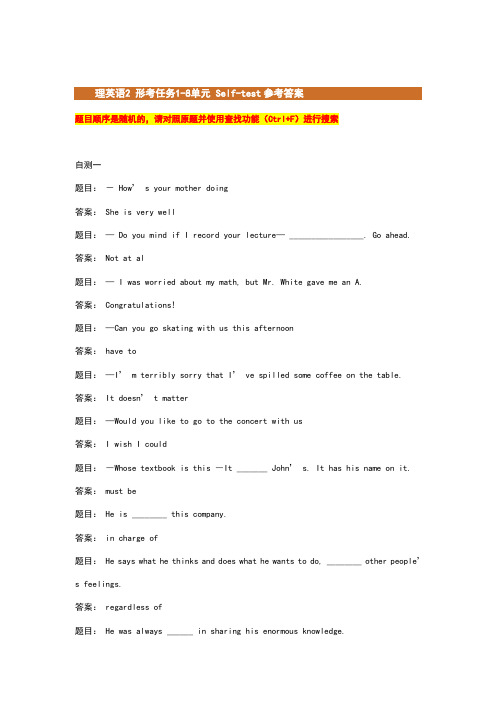
2题目顺序是随机的,请对照原题并使用查找功能(Ctrl+F)进行搜索自测一题目:- How’ s your mother doing答案: She is very well题目:— Do you mind if I record your lecture— _________________. Go ahead.答案: Not at al题目:— I was worried about my math, but Mr. White gave me an A.答案: Congratulations!题目:—Can you go skating with us this afternoon答案: have to题目:—I’ m terribly sorry that I’ ve spilled some coffee on the table.答案: It doesn’ t matter题目:—Would you like to go to the concert with us答案: I wish I could题目:―Whose textbook is this ―It _______ John’ s. It has his name on it.答案: must be题目: He is ________ this company.答案: in charge of题目: He says what he thinks and does what he wants to do, ________ other people’s feelings.答案: regardless of题目: He was always ______ in sharing his enormous knowledge.答案: generous题目: His action is always ______ with his words.答案: consistent题目: More than 30 people ______ the position.答案: applied for题目: One day, our dreams will ____________ reality.答案: turn into题目: The enemy has strengthened their ______ position.答案: defensive题目: We think that Smith should be told about his ______ condition as soon aspossible.答案: physical二、翻译:从以下 A、 B、 C 三个选项中选出与英文最适合的中文翻译。
外文翻译---基于事例推理的夹具设计研究与应用
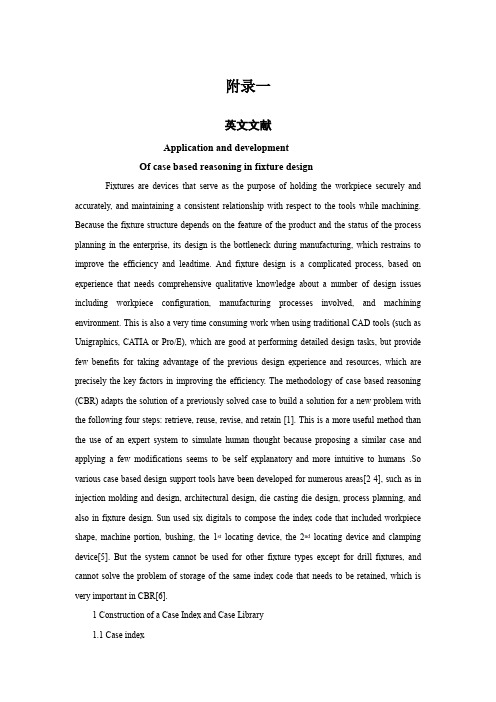
附录一英文文献Application and developmentOf case based reasoning in fixture designFixtures are devices that serve as the purpose of holding the workpiece securely and accurately, and maintaining a consistent relationship with respect to the tools while machining. Because the fixture structure depends on the feature of the product and the status of the process planning in the enterprise, its design is the bottleneck during manufacturing, which restrains to improve the efficiency and leadtime. And fixture design is a complicated process, based on experience that needs comprehensive qualitative knowledge about a number of design issues including workpiece configuration, manufacturing processes involved, and machining environment. This is also a very time consuming work when using traditional CAD tools (such as Unigraphics, CATIA or Pro/E), which are good at performing detailed design tasks, but provide few benefits for taking advantage of the previous design experience and resources, which are precisely the key factors in improving the efficiency. The methodology of case based reasoning (CBR) adapts the solution of a previously solved case to build a solution for a new problem with the following four steps: retrieve, reuse, revise, and retain [1]. This is a more useful method than the use of an expert system to simulate human thought because proposing a similar case and applying a few modifications seems to be self explanatory and more intuitive to humans .So various case based design support tools have been developed for numerous areas[2-4], such as in injection molding and design, architectural design, die casting die design, process planning, and also in fixture design. Sun used six digitals to compose the index code that included workpiece shape, machine portion, bushing, the 1st locating device, the 2nd locating device and clamping device[5]. But the system cannot be used for other fixture types except for drill fixtures, and cannot solve the problem of storage of the same index code that needs to be retained, which is very important in CBR[6].1 Construction of a Case Index and Case Library1.1 Case indexThe case index should be composed of all features of the workpiece, which are distinguished from different fixtures. Using all of them would make the operation in convenient. Because the forms of the parts are diverse, and the technology requirements of manufacture in the enterprise also develop continuously, lots of features used as the case index will make the search rate slow, and the main feature unimportant, for the reason that the relative weight which is allotted to every feature must diminish. And on the other hand, it is hard to include all the features in the case index.Therefore, considering the practicality and the demand of rapid design, the case index includes both the major feature of the workpiece and the structure of fixture. The case index code is made up of 16 digits: 13 digits for case features and 3 digits for case identification number.The first 13 digits represent 13 features. Each digit is corresponding to an attribute of the feature, which may be one of“*”, “?”, “1”, “2”,…,“A”,“B”,…, “Z”,…, etc. In which, “*” means anyone, “?” uncertain, “0” nothing.The system rules: fixture type, workpiece shape, locating model cannot be “*”or“?”. When the system is designed, the attribute information of the three items does not have these options, which means the certain attribute must be selected.The last three digits are the case identification number, which means the 13 digits of the case feature are the same, and the number of these three digits is used for distinguishing them.The system also rules: “000” is a prototype case, which is used for retrieval, and other cases are “001”,“002”,…, which are used for reference cases to be searched by designers. If occasionally one of them needs to be changed as the prototype case, first it must be required to apply to change the one to “000”, and the former is changed to referential case automatically.The construction of the case index code is shown in Fig.1.1.2 Case libraryThe case library consists of lots of predefined cases. Case representation is one of the mostimportant issues in case based reasoning. So compounding with the index code,.1.3 Hierarchical form of CaseThe structure similarity of the fixture is represented as the whole fixture similarity, components similarity and component similarity. So the whole fixture case library, components case library, component case library of fixture are formed correspondingly. Usually design information of the whole fixture is composed of workpiece information and workpiece procedure information, which represent the fixture satisfying the specifically designing function demand. The whole fixture case is made up of function components, which are described by the function components’ names and numbers. The components case represent s the members. (function component and other structure components,main driven parameter, the number, and their constrain relations.) The component case (the lowest layer of the fixture) is the structure of function component and other components. In the modern fixture design there are lots of parametric standard parts and common non standard parts. So the component case library should record the specification parameter and the way in which it keeps them.2 Strategy of Case RetrievalIn the case based design of fixtures ,the most important thing is the retrieval of the similarity, which can help to obtain the most similar case, and to cut down the time of adaptation. According to the requirement of fixture design, the strategy of case retrieval combines the way of the nearest neighbor and knowledge guided. That is, first search on depth, then on breadth; the knowledge guided strategy means to search on the knowledge rule from root to the object, which is firstly searched by the fixture type, then by the shape of the workpiece, thirdly by the locating method. For example, if the case index code includes the milling fixture of fixture type, the search is just for all milling fixtures, then for box of workpiece shape, the third for 1plane+ 2pine of locating method. If there is no match of it, then the search stops on depth, and returns to the upper layer, and retrieves all the relative cases on breadth.Retrieval algorithms:1)According to the case index information of fixture case library, search the relevant case library;2)Match the case index code with the code of each case of the case library, and calculate the value of the similarity measure;3)Sort the order of similarity measure, the biggest value, which is the most analogical case.Similarity between two cases is based on the similarity between the two cases. features. The calculation of similarity measure depends on the type of the feature. The value of similarity can be calculated for numerical values, for example, compareWorkpiece with the weight of 50kg and 20kg. The value can also be calculated between non numerical values, for example, now the first 13 digits index code is all non numerical values. The similarity measure of a fixture is calculated as follows:where S is the similarity measure of current fixture, n is the number of the index feature,is the weight of each feature, is the similarity measure of the attribute of the i2th feature with the attribute of relative feature of the j-th case in the case library. At the same time, , the value counts as follows:.Where is the value of the index attribute of the i-th feature, and is the value of attribute of the relative i-th feature of the j-th case in case library.So there are two methods to select the analogical fixture. One is to set the value. If the values of similarity measure of current cases were less than a given value, those cases would not be selected as analogical cases. When the case library is initially set up, and there are only a few cases, the value can be set smaller. If there are lots of analogical cases, the value should get larger. The other is just to set the number of the analogical cases (such as10), which is the largest value of similarity measure from the sorted order.3 Case adaptation and Case Storage3.1 Case adaptationThe modification of the analogical case in the fixture design includes the following three cases:1) The substitution of components and the component;2) Adjusting the dimension of components and the component while the form remains;3) The redesign of the model.If the components and component of the fixture are common objects, they can be edited, substituted and deleted with tools, which have been designed.3.2 Case storageBefore saving a new fixture case in the case library, the designer must consider whether the saving is valuable. If the case does not increase the knowledge of the system, it is not necessary to store it in the case library. If it is valuable, then the designer must analyze it before saving it to see whether the case is stored as a prototype case or as reference case. A prototype case is a representation that can describe the main features of a case family. A case family consists of those cases whose index codes have the same first 13 digits and different last three digits in the case library. The last three digits of a prototype case are always “000”. A reference case belongs to the same family as the prototype case and is distinguished by the different last three digits.From the concept that has been explained, the following strategies are adopted:1) If a new case matches any existing case family, it has the same first 13 digits as an existing prototype case, so the case is not saved because it is represented well by the prototype case. Or is j ust saved as a reference case (the last 3 digits are not “000”, and not the same with others) in the case library.2) If a new case matches any existing case family and is thought to be better at representing this case family than the previous prototype case, then the prototype case is substituted by this new case, and the previous prototype case is saved as a reference case.3) If a new case does not match any existing case family, a new case family will be generated automatically and the case is stored as the prototype case in the case library.4 Process of CBR in Fixture DesignAccording to the characteristics of fixture design, the basic information of the fixture designsuch as the name of fixture, part, product and the designer, etc. must be input first. Then the fixture file is set up automatically, in which all components of the fixture are put together. Then the model of the workpiece is input or designed. The detailed information about the workpiece is input, the case index code is set up, and then the CBR begins to search the analogical cases, relying on the similarity measure, and the most analogical case is selected out. If needed, the case is adapted to satisfy the current design, and restored into the case library. The flowchart of the process is shown in Fig.3.5 Illustrating for Fixture Design by CBRThis is a workpiece (seeFig.4). Its material is 45# steel. Its name is seat. Its shape is block, and the product batch size is middle, etc. A fixture is turning fixture that serves to turn the hole, which needs to be designed.The value of feature, attribute, case index code and weight of the workpiece is show n inTab.2.Through searching, and calculating the similarity, the case index code of the most similar case is 19325513321402000, and the detailed information is show n in Tab. 3.The similarity is calculated as follows:So the value of similarity measure of the fixture which needs to be designed with the most analogical case in case library is 0.806, and the structure of the most analogical case is shown in Fig.5.After having been substituted the component, modified the locating model and clamp model, and adjusted the relative dimension, the new fixture is designed, and the figure is show n in Fig.6.As there is not the analogical fixture in the case library, the new fixture is restored in to the case library. The case index code is 19325513311402000.6 ConclusionCBR, as a problem solving methodology, is a more efficient method than an expert system to simulate human thought, and has been developed in many domains where knowledge is difficult to acquire. The advantages of the CBR are as follows: it resembles human thought more closely; the building of a case library which has self learning ability by saving new cases is easier and faster than the building of a rule library; and it supports a better transfer and explanation of new knowledge that is more different than the rule library. A proposed fixture design framework on the CBR has been implemented by using Visual C ++, UG/Open API in U n graphics with Oracle as database support, which also has been integrated with the 32D parametric common component library, common components library and typical fixture library. The prototype system, developed here, is used for the aviation project, and aids the fixture designers to improve the designefficiency and reuse previous design resources.外文翻译基于事例推理的夹具设计研究与应用夹具是以确定工件安全定位准确为目的的装置,并在加工过程中保持工件与刀具或机床的位置一致不变。
波特的价值链模型中英

Chapter 6 Strategic Information System: Information Technology’s Application for Enterprise Strategy.波特的价值链模型(Porter’s Value-Chain Model)企业的产品利润系基企业一连串的加值活动(Value-Add Activities)所产生,而企业的加值活动分为主要活动(Primary Activities)与支持活动(SupportActivities)。
主要活动系为与产品与服务有直接关联的活动,而支持活动则包含支持主要活动,但与产品与服务无直接关联的所有措施(包含管理与支持的活动)。
主要活动分为「进货后勤(Inbound Logistic)」、「生产制造(Operation)」、「出货后勤(Outbound Logistic)」、「营销销售(Sale and Marketing)」、「售后服务(Service)」五大项,主掌产品与服务的生产过程。
支持活动则涵盖了整个主要活动的范畴,如采购管理(Procurement)、科技开发(Technology Development)、人力资源管理(Human Resource Management)、财务会计管理(FinancialManagement)、企业的基础设施(Enterprise Infrastructure)等。
策略推力模型(Strategic Thrust Model)五个策略攻击的领域:✧差异化(Differentiation)-企业选择一种或数种对顾客有价值的需求,以自身优势的能力,单独满足这些需求,让其他对手在顾客认知上产生差异。
✧成本(Cost)-提供相当利益给顾客,但价格较低,竞争优势以降低成本为主要手段。
✧创新(Innovation)-开发新产品、服务或创新作业流程。
✧成长(Growth)-利用营业额、规模、市场、产品范围的扩大与提升来创造及维持其优势。
塑性专业词汇
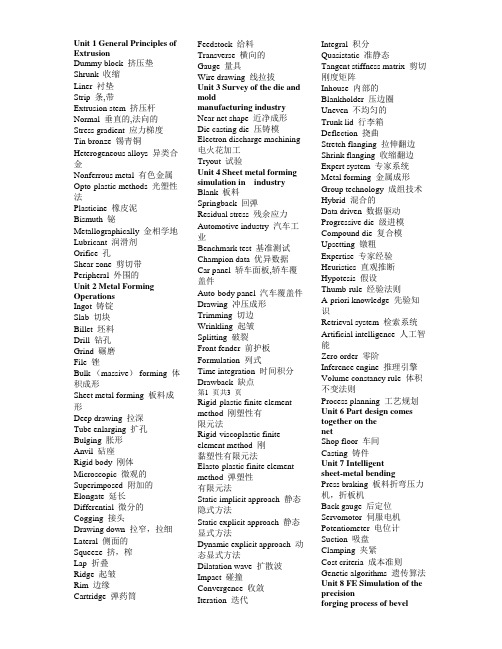
Unit 1 General Principles of ExtrusionDummy block 挤压垫Shrunk 收缩Liner 衬垫Strip 条,带Extrusion stem 挤压杆Normal 垂直的,法向的Stress gradient 应力梯度Tin bronze 锡青铜Heterogeneous alloys 异类合金Nonferrous metal 有色金属Opto-plastic methods 光塑性法Plasticine 橡皮泥Bismuth 铋Metallographically 金相学地Lubricant 润滑剂Orifice 孔Shear zone 剪切带Peripheral 外围的Unit 2 Metal Forming OperationsIngot 铸锭Slab 切块Billet 坯料Drill 钻孔Grind 碾磨File 锉Bulk (massive)forming 体积成形Sheet metal forming 板料成形Deep drawing 拉深Tube enlarging 扩孔Bulging 胀形Anvil 砧座Rigid body 刚体Microscopic 微观的Superimposed 附加的Elongate 延长Differential 微分的Cogging 接头Drawing down 拉窄,拉细Lateral 侧面的Squeeze 挤,榨Lap 折叠Ridge 起皱Rim 边缘Cartridge 弹药筒Feedstock 给料Transverse 横向的Gauge 量具Wire drawing 线拉拔Unit 3 Survey of the die andmoldmanufacturing industryNear net shape 近净成形Die casting die 压铸模Electron discharge machining电火花加工Tryout 试验Unit 4 Sheet metal formingsimulation in industryBlank 板料Springback 回弹Residual stress 残余应力Automotive industry 汽车工业Benchmark test 基准测试Champion data 优异数据Car panel 轿车面板,轿车覆盖件Auto-body panel 汽车覆盖件Drawing 冲压成形Trimming 切边Wrinkling 起皱Splitting 破裂Front fender 前护板Formulation 列式Time integration 时间积分Drawback 缺点第1 页共3 页Rigid-plastic finite elementmethod 刚塑性有限元法Rigid-viscoplastic finiteelement method 刚黏塑性有限元法Elasto-plastic finite elementmethod 弹塑性有限元法Static implicit approach 静态隐式方法Static explicit approach 静态显式方法Dynamic explicit approach 动态显式方法Dilatation wave 扩散波Impact 碰撞Convergence 收敛Iteration 迭代Integral 积分Quasistatic 准静态Tangent stiffness matrix 剪切刚度矩阵Inhouse 内部的Blankholder 压边圈Uneven 不均匀的Trunk lid 行李箱Deflection 挠曲Stretch flanging 拉伸翻边Shrink flanging 收缩翻边Expert system 专家系统Metal forming 金属成形Group technology 成组技术Hybrid 混合的Data driven 数据驱动Progressive die 级进模Compound die 复合模Upsetting 镦粗Expertise 专家经验Heuristics 直观推断Hypotesis 假设Thumb-rule 经验法则A-priori knowledge 先验知识Retrieval system 检索系统Artificial intelligence 人工智能Zero order 零阶Inference engine 推理引擎Volume constancy rule 体积不变法则Process planning 工艺规划Unit 6 Part design comestogether on thenetShop floor 车间Casting 铸件Unit 7 Intelligentsheet-metal bendingPress braking 板料折弯压力机,折板机Back gauge 后定位Servomotor 伺服电机Potentiometer 电位计Suction 吸盘Clamping 夹紧Cost criteria 成本准则Genetic algorithms 遗传算法Unit 8 FE Simulation of theprecisionforging process of bevelgearsFE simulation 有限元模拟Numerical simulation 数值模拟Precision forging 精密锻造Bevel gear 伞齿轮Close die forging 闭式模锻Scale 氧化皮Ball imprint 球磨Concentrity 同心性Graphite-water suspension 石墨乳液Thermo-mechanical coupled analysis 热力耦合分析Force-travel course 力-行程曲线Axial 轴向Radial 径向Erosion 腐蚀Unit 9 Towards Clean Forming Techniques Clean Forming 洁净成形Cleaning agent 清洁剂Sludge 残渣,油泥Patenting 拉丝后退火Salt bath 盐浴Pearlitic 珠光体的Cold welding 冷焊Roughness 粗糙度Polymer 聚合物Backward extrusion 反向挤压Rolling 轧制第2 页共3 页Unit 10Computer-integrated ball burnishing of aplastic-injection-mould cavity insertState of art 工艺水平,工艺现状Plastic injection mould 注塑模Cavity insert 阴模镶块Blind hole 盲孔Through hole 通孔Tapered hole 锥形孔Free- form 自由形态Fillet radius 圆角半径Draft angle 拔模角;锻模斜度Cemented carbide 硬质合金Face milling 平面铣刀Unit 11 Application of casebased reasoningin injection mouldingCase based reasoning 基于实例的推理Rheology 流变学Prototype 原型Rapid Prototype 快速原型Unit 12 Control of blankholder force toeliminate wrinkling andfracture indeep – drawing rectangularpartsBlank holder force 压边力Deep-drawing 拉深Stretch forming 拉形,张拉成形Die cushion 模垫Loadcell 测力仪Pin 销,顶杆Oblong 长方形Drawbead 拉延筋Membrane 膜Restraining force 约束力Circumferential stress 切向应力Flange 法兰,凸缘Amplitude 振幅Wavelength 波长Trajectory 抛物线Unit 13 Recentdevelopments in ring rollingapplications and rotaryforgingRing rolling 环锻, 环轧Rotary forging 旋转锻造Hot rolling 热轧Cold rolling 冷轧Profile rolling 型材轧制,型轧Ring gear rolling 齿轮环轧制Warm forging 温锻Cold forging 冷锻Cross rolling 横轧Closed die forging 闭式模锻Unit 14 From CAD art torapid metal toolsFree form fabrication 自由成形加工Cermet 金属陶瓷Root mean square 均方根Powder metal sintering 粉末金属烧结Master pattern 原型,母模Curing 烘焙Warpage 翘曲Demold 脱模Parting plane 分模面Electroforming 电铸成形Vacuum cast 真空铸造Unit 15 An intelligentinterface betweensymbolic and numericanalysis toolsrequired for thedevelopment of anintegrated CAD systemIntelligent computer aideddesign 智能CADKnowledge based engineeringsystem KBEs基于知识的工程系统Discretization 离散化Plate 板Shell 壳Node 节点Element 单元Mesh 网格Meshless 无网格的Loading conditions 载荷条件Boundary conditions 边界条件Artificial intelligence 人工智能Object oriented 面向对象的第3 页共3 页。
中英互译
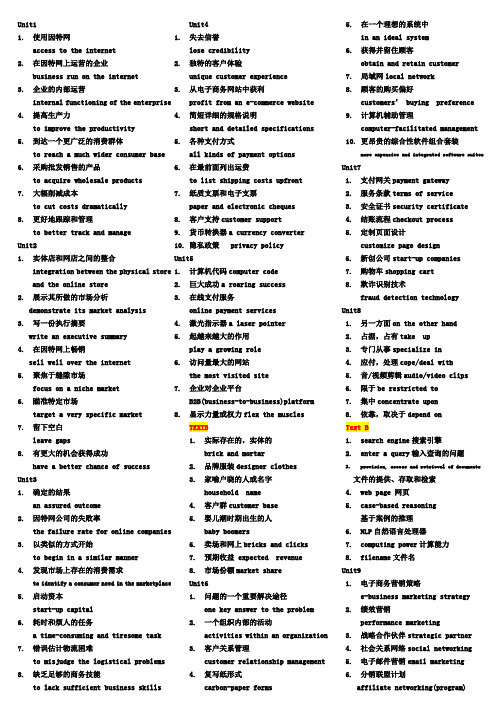
Unit11.使用因特网access to the internet2.在因特网上运营的企业business run on the internet3.企业的内部运营internal functioning of the enterprise 4.提高生产力to improve the productivity5.到达一个更广泛的消费群体to reach a much wider consumer base 6.采购批发销售的产品to acquire wholesale products7.大幅削减成本to cut costs dramatically8.更好地跟踪和管理to better track and manageUnit21.实体店和网店之间的整合integration between the physical store and the online store2.展示其所做的市场分析demonstrate its market analysis3.写一份执行摘要write an executive summary4.在因特网上畅销sell well over the internet5.聚焦于缝隙市场focus on a niche market6.瞄准特定市场target a very specific market7.留下空白leave gaps8.有更大的机会获得成功have a better chance of successUnit31.确定的结果an assured outcome2.因特网公司的失败率the failure rate for online companies 3.以类似的方式开始to begin in a similar manner4.发现市场上存在的消费需求to identify a consumer need in the marketplace 5.启动资本start-up capital6.耗时和烦人的任务a time-consuming and tiresome task7.错误估计物流困难to misjudge the logistical problems 8.缺乏足够的商务技能to lack sufficient business skills Unit41.失去信誉lose credibility2.独特的客户体验unique customer experience3.从电子商务网站中获利profit from an e-commerce website4.简短详细的规格说明short and detailed specifications5.各种支付方式all kinds of payment options6.在最前面列出运费to list shipping costs upfront7.纸质支票和电子支票paper and electronic cheques8.客户支持customer support9.货币转换器a currency converter10.隐私政策 privacy policyUnit51.计算机代码computer code2.巨大成功a roaring success3.在线支付服务online payment services4.激光指示器a laser pointer5.起越来越大的作用play a growing role6.访问量最大的网站the most visited site7.企业对企业平台B2B(business-to-business)platform8.显示力量或权力flex the musclesTEXTB1.实际存在的,实体的brick and mortar2.品牌服装designer clothes3.家喻户晓的人或名字household name4.客户群customer base5.婴儿潮时期出生的人baby boomers6.卖场和网上bricks and clicks7.预期收益 expected revenue8.市场份额market shareUnit61.问题的一个重要解决途径one key answer to the problem2.一个组织内部的活动activities within an organization3.客户关系管理customer relationship management4.复写纸形式carbon-paper forms5.在一个理想的系统中in an ideal system6.获得并留住顾客obtain and retain customer7.局域网local network8.顾客的购买偏好customers’ buying preference 9.计算机辅助管理computer-facilitated management 10.更昂贵的综合性软件组合套装more expensive and integrated software suites Unit71.支付网关payment gateway2.服务条款terms of service3.安全证书security certificate4.结账流程checkout process5.定制页面设计customize page design6.新创公司start-up companies7.购物车shopping cart8.欺诈识别技术fraud detection technologyUnit81.另一方面on the other hand2.占据,占有take up3.专门从事specialize in4.应付,处理cope/deal with5.音/视频剪辑audio/video clips6.限于be restricted to7.集中concentrate upon8.依靠,取决于depend onText B1.search engine搜索引擎2.enter a query输入查询的问题3.provision, access and retrieval of documents文件的提供、存取和检索4.web page 网页5.case-based reasoning基于案例的推理6.NLP自然语言处理器puting power计算能力8.filename文件名Unit91.电子商务营销策略e-business marketing strategy 2.绩效营销performance marketing3.战略合作伙伴strategic partner4.社会关系网络social networking5.电子邮件营销email marketing6.分销联盟计划affiliate networking(program)7.提升销量和流量boost sales and traffic8.成倍增加在线收入exponentially grow your online revenue Unit101.解决争端resolve disputes2.资产保护protection of assets3.经商conduct business4.无数变量numerous variables5.监管机构supervisory/regulatory authority6.人力资源human resources7.关键因素key factors8.电子签名electronic signature9.商品活动business activity10.商业价值commercial value11.确保可执行性ensure enforceability12.信息产品information productsUnit111.建立安全措施institute security measures2.平息不安quell the uneasiness3.网络入侵者online intruders4.(像虫子一样)钻进worm one’s way into5.关闭电脑shut down the computer6.未授权访问unauthorized access7.备份协议a backup protocol8.令人瞩目的网站high-profile sites Text B风险意识risk consciousness风险评估risk assessment传输机制transport mechanism政策实施与执行policy implementation and enforcement安全策略security strategy系统效能system effectivenessunit121.当今的趋势the current trends2.地理区域geographic zones3.智能手机smart phones4.移动商务mobile commerce /business(m-commerce/business5.潜在客户potential customers6.网络账户online accounts7.搜索引擎优化服务SEO service8.零售业retail industry1.customer relationship management客户关系管理2.enterprise resource planning企业资源计划3. a comprehensive eCRM system综合电子客户关系管理系统4.department of customer service客户服务部门5.web technology 网络技术6.customized software按客户要求开发的软件,定制软件7.exchange customer information交换客户信息8.vertical market 纵向市场9.feedback from the customer客户的反馈10.business practices 商务运作,商务活动11.obtain and retain customers赢得和留住客户12.sales-force automation 销售队伍自动化13.customize these packages定制这些软件包14.browser-equipped phones and laptops配有浏览器的电话和手提电脑15.traditional contact management传统的客户接触管理。
科技英语课文句子翻译Unit110
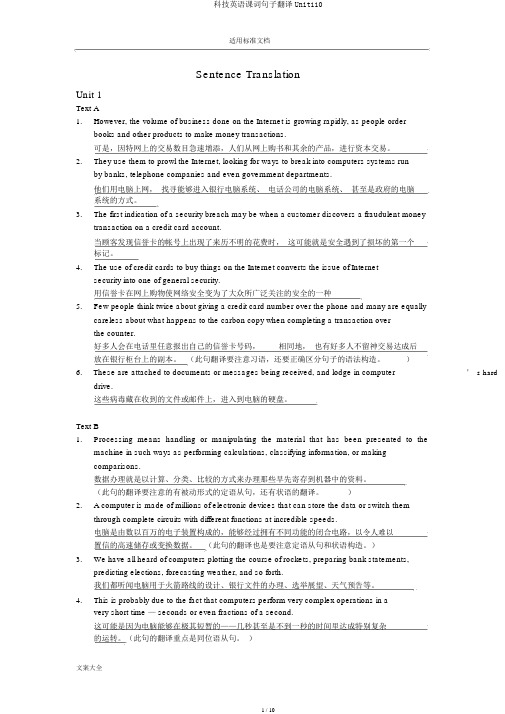
科技英语课词句子翻译Unit110适用标准文档Sentence TranslationUnit 1Text A1.However, the volume of business done on the Internet is growing rapidly, as people orderbooks and other products to make money transactions.可是,因特网上的交易数目急速增添,人们从网上购书和其余的产品,进行资本交易。
2.They use them to prowl the Internet, looking for ways to break into computers systems runby banks, telephone companies and even government departments.他们用电脑上网,找寻能够进入银行电脑系统、电话公司的电脑系统、甚至是政府的电脑系统的方式。
3.The first indication of a security breach may be when a customer discovers a fraudulent moneytransaction on a credit card account.当顾客发现信誉卡的帐号上出现了来历不明的花费时,这可能就是安全遇到了损坏的第一个标记。
4.The use of credit cards to buy things on the Internet converts the issue of Internetsecurity into one of general security.用信誉卡在网上购物使网络安全变为了大众所广泛关注的安全的一种5.Few people think twice about giving a credit card number over the phone and many are equallycareless about what happens to the carbon copy when completing a transaction overthe counter.好多人会在电话里任意报出自己的信誉卡号码,相同地,也有好多人不留神交易达成后放在银行柜台上的副本。
CASE-BASED REASONING SYSTEM AND METHOD HAVING FAUL
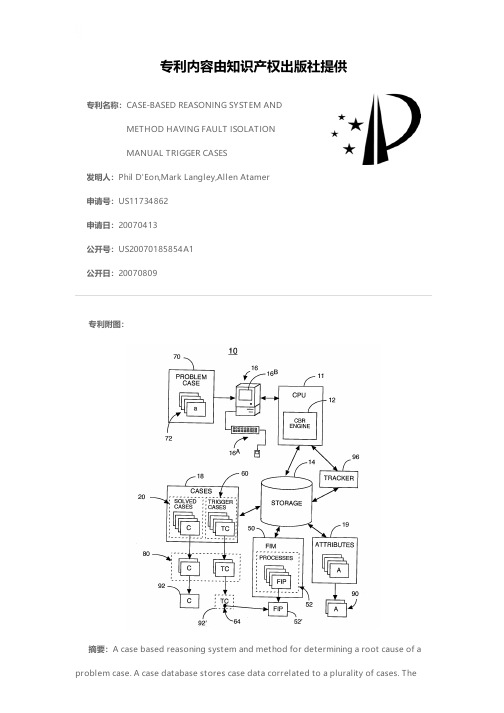
专利名称:CASE-BASED REASONING SYSTEM ANDMETHOD HAVING FAULT ISOLATIONMANUAL TRIGGER CASES发明人:Phil D'Eon,Mark Langley,Allen Atamer申请号:US11734862申请日:20070413公开号:US20070185854A1公开日:20070809专利内容由知识产权出版社提供专利附图:摘要:A case based reasoning system and method for determining a root cause of a problem case. A case database stores case data correlated to a plurality of cases. Theplurality of cases includes at least one solved case, and at least one trigger case. Each solved case in the case database includes root cause data, and each trigger case comprises a data link to at least one fault isolation manual process for determining a root cause. A processor determines a list of at least one potential case selected from said plurality of cases by comparing the at least one problem attribute value to the set of attribute values for each of the plurality of cases.申请人:Phil D'Eon,Mark Langley,Allen Atamer地址:Bolton CA,Mississauga CA,Richmond Hill CA国籍:CA,CA,CA更多信息请下载全文后查看。
知识推理
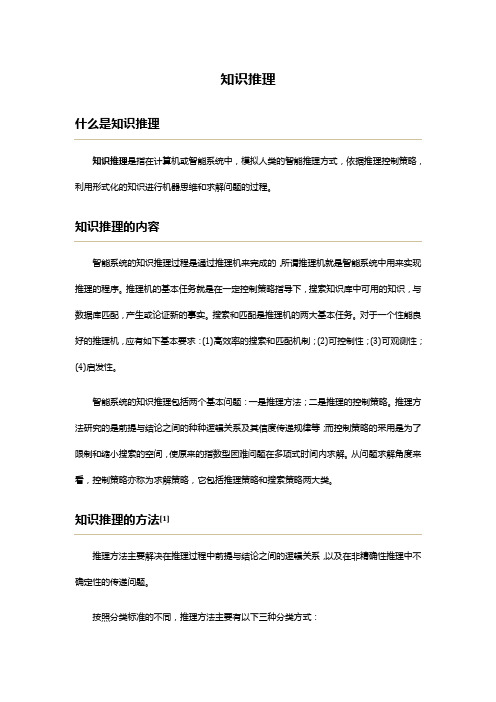
知识推理什么是知识推理知识推理是指在计算机或智能系统中,模拟人类的智能推理方式,依据推理控制策略,利用形式化的知识进行机器思维和求解问题的过程。
知识推理的内容智能系统的知识推理过程是通过推理机来完成的,所谓推理机就是智能系统中用来实现推理的程序。
推理机的基本任务就是在一定控制策略指导下,搜索知识库中可用的知识,与数据库匹配,产生或论证新的事实。
搜索和匹配是推理机的两大基本任务。
对于一个性能良好的推理机,应有如下基本要求:(1)高效率的搜索和匹配机制;(2)可控制性;(3)可观测性;(4)启发性。
智能系统的知识推理包括两个基本问题:一是推理方法;二是推理的控制策略。
推理方法研究的是前提与结论之间的种种逻辑关系及其信度传递规律等;而控制策略的采用是为了限制和缩小搜索的空间,使原来的指数型困难问题在多项式时间内求解。
从问题求解角度来看,控制策略亦称为求解策略,它包括推理策略和搜索策略两大类。
知识推理的方法[1]推理方法主要解决在推理过程中前提与结论之间的逻辑关系,以及在非精确性推理中不确定性的传递问题。
按照分类标准的不同,推理方法主要有以下三种分类方式:从方式上分,可分为演绎推理和归纳推理;从确定性上分,可分为精确推理和不精确推理;从单调性上分,可分为单调推理和非单调推理。
知识推理的控制策略[1](1)推理策略。
主要包括正向推理、反向推理和混合推理。
正向推理又称为事实驱动或数据驱动推理,其主要优点是比较直观,允许用户提供有用的事实信息,是产生式专家系统的主要推理方式之一。
反向推理又称目标驱动或假设驱动推理,其主要优点是不必使用与总目标无关的规则,且有利于向用户提供解释。
正反向混合推理可以克服正向推理和反向推理问题求解效率较低的缺点。
基于神经网络的知识推理既可以实现正向推理,又可以实现反向推理。
在研制结构选型智能设计系统时,应结合具体情况选择合适的推理策略。
(2)搜索策略。
搜索策略主要包括盲目搜索和启发式搜索,前者包括深度优先搜索和宽度优先搜索等搜索策略;后者包括局部择优搜索法(如瞎子爬山法)和最好优先搜索法(如有序搜索法)等搜索策略。
雅思Uovrxq雅思阅读高频考点句式特征

2 并列句和动词连动
并列句:He would write a dictionary himself; and he would do it single-handed.
动词连动:The dictionary, together with his other writing, made Johnson famous and so well esteemed that his friends were able to prevail upon King George III to offer him a pension.
3.宾语从句
Milgram told each volunteer 'teacher-subject' that the experiment was in the noble cause of education, and was designed to test whether or not punishing pupils for their mistakes would have a positive effect on the pupils' ability to learn.(and 前后都是考点)
平行结构:
(1)Most forms of environmental pollution either appear to have been exaggerated, or are transient and therefore best cured not by restricting economic growth, but by accelerating it.
Working to a deadline, he had to draw on the best of all previous dictionaries, and to make his work one of heroic synthesis.
Lazy和Eager分类算法
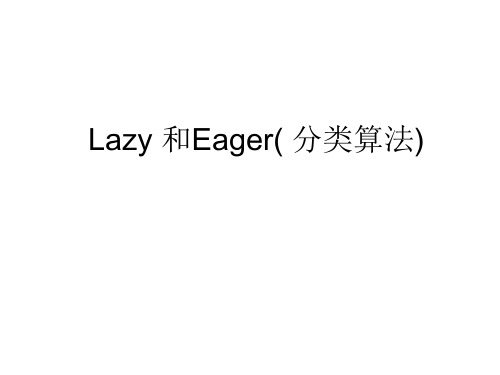
概述
人们为了解决一个新问题,先是进行回忆,从记忆中 找到一个与新问题相似的范例,然后把该范例中的有 关信息和知识复用到新问题的求解之中。
• Summarization on RBF
– To provide a global approximation to the target function – Represented by a linear combination of many local kernel functions – To neglect the values out of defined region(region/width) – Can be trained more efficiently
• Instance representation V—feature vector <a1(x ), a2(x ),… an(x ) > • Distance metric(Euclidean distance)
d ( xi , x j )
(a ( x ) a ( x ))
r 1 r i r j
2 q
x k nearest nbrs of xq
ˆ ( x)) a ( x) K (d ( xq , x))( f ( x) f
j
[Atkeson,1997 & Bishop,1995]
Radial Basis Function
Related to distance-weighted regression & artificial neural networks [Powell,1987; Broomhead & Lowe 1988; Moody
ˆ ( x)) ( x) f
注塑模具英文文献
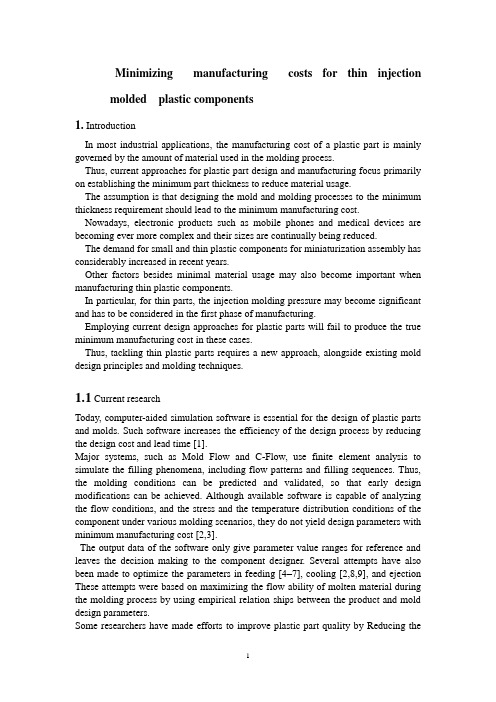
Employing current design approaches for plastic parts will fail to produce the true minimum manufacturing cost in these cases.
Minimizing manufacturing costs for thin injection
molded plastic components
1. Introduction
In most industrial applications, the manufacturing cost of a plastic part is mainly governed by the amount of material used in the molding procend the part deformation after molding [12], analyzing the effects of wall thickness and the flow length of the part [13], and analyzing the internal structure of the plastic part design and filling materials flows of the mold design [14]. Reifschneider [15] has compared three types of mold filling simulation programs, including Part Adviser, Fusion, and Insight, with actual experimental testing. All these approaches have established methods that can save a lot of time and cost. However, they just tackled the design parameters of the plastic part and mold individually during the design stage. In addition, they did not provide the design parameters with minimum manufacturing cost. Studies applying various artificial intelligence methods and techniques have been found that mainly focus on optimization analysis of injection molding parameters [16,17]. For in-stance He et al. [3] introduced a fuzzy- neuro approach for automatic resetting of molding process parameters. By contrast , Helps et al. [18,19] adopted artificial neural networks to predict the setting of molding conditions and plastic part quality control in molding. Clearly, the development of comprehensive molding process models and computer-aided manufacturing provides a basis for realizing molding parameter optimization [3 , 16,17]. Mok et al. [20] propose a hybrid neural network and genetic algorithm approach incorporating Case-Based Reasoning (CBR) to derive initial settings for molding parameters for parts with similar design features quickly and with acceptable accuracy. Mok’s approach was based on past product processing data, and was limited to designs that are similar to previous product data. However, no real R&D effort has been found that considers minimizing manufacturing costs for thin plastic components. Generally, the current practical approach for minimizing the manufacturing cost of plastic components is to minimize the thickness and the dimensions of the part at the product design stage, and then to calculate the costs of the mold design and molding process for the part accordingly, as shown in Fig. 1. The current approach may not be able to obtain the real minimum manufacturing cost when handling thin plastic components. 1.2Manufacturing requirements for a typical thin plastic component As a test example, the typical manufacturing requirements for a thin square plastic part with a center hole, as shown in Fig. 2, are given in Table 1.
管理英语2形考参考答案
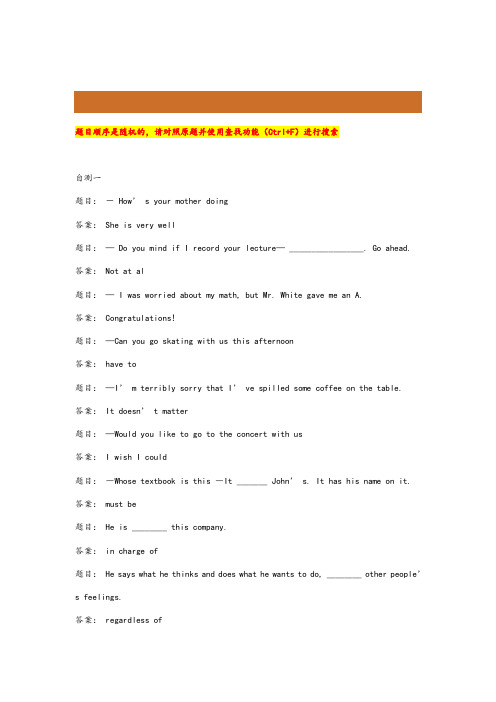
题目顺序是随机的,请对照原题并使用查找功能(Ctrl+F)进行搜索自测一题目:- How’ s your mother doing答案: She is very well题目:— Do you mind if I record your lecture— _________________. Go ahead.答案: Not at al题目:— I was worried about my math, but Mr. White gave me an A.答案: Congratulations!题目:—Can you go skating with us this afternoon答案: have to题目:—I’ m terribly sorry that I’ ve spilled some coffee on the table.答案: It doesn’ t matter题目:—Would you like to go to the concert with us答案: I wish I could题目:―Whose textbook is this ―It _______ John’ s. It has his name on it.答案: must be题目: He is ________ this company.答案: in charge of题目: He says what he thinks and does what he wants to do, ________ other people’s feelings.答案: regardless of题目: He was always ______ in sharing his enormous knowledge.答案: generous题目: His action is always ______ with his words.答案: consistent题目: More than 30 people ______ the position.答案: applied for题目: One day, our dreams will ____________ reality.答案: turn into题目: The enemy has strengthened their ______ position.答案: defensive题目: We think that Smith should be told about his ______ condition as soon aspossible.答案: physical二、翻译:从以下 A、 B、 C 三个选项中选出与英文最适合的中文翻译。
问题情境创设课题参考文献

课题题目:问题情境创设参考文献60篇(中文+英文)以下是相关的30篇中文参考文献:[1]钟秉林. (1998). 认知心理学的学习观. 心理科学进展, 6(4), 39-44.[2]蒋莉莉,章玉凡. (2016). 基于问题的深度学习研究. 教育研究, 37(1), 14-22.[3]杨溥. (1998). 教育技术应用中的创设学习环境. 电化教育研究, 19(4), 45-51.[4]吴捷,张文新,黄亚达. (2009). 问题情境学习环境的设计和应用. 电化教育研究, 10, 51-54.[5]梁长荣. (2012). 基于问题学习的教育课堂策略初探. 现代教育科学, 18, 34-36.[6]李玉季. (2002). 浅析问题情境创设在课堂教学中的作用. 教育研究与实验, 02, 68-69.[7]叶秀兰. (2016). 从“问题情境创设”看高校教育教学改革. 创新教育研究, 05, 58-61.[8]安家喻,侯伟. (2015). 情境教学法研究综述. 大连民族学院学报, 17, 56-61.[9]王端乾等. (2017). 学科教育技术基础. 上海教育出版社.[10]杜晓红. (2016). 高校教师教学能力培养研究. 北京师范大学出版社.[11]李纲. (2016). 教育技术:理论、应用与开发. 浙江大学出版社.[12]朱仲义. (2009). 创设性教学模式研究. 高等教育研究, 05, 80-86.[13]陈琪. (2014). 问题情境创设的课堂教学模式探析. 科学咨询研究, 06, 63-66.[14]曾荣玲. (2000). 认知心理学与现代教学设计. 安徽师范大学出版社.[15]刘红彦. (2006). 教育软件设计及应用. 电子工业出版社.[16]王雪,王书平. (2005). 基于构造主义的课堂教学设计理论与实践. 中国教育出版社.[17]岳晓东. (2010). 构造主义视阈下的教师职业发展研究. 北京大学出版社.[18]刘建中. (2008). 创设一体化学习环境. 重庆出版社.[19]张维喆,张晓龙. (2011). 问题情境创设的新课标语文课堂教学研究. 教育研究与实验, 03, 53-56.[20]张晋新. (2006). 学习共同体理论:教育革新的新起点. 吉林教育科学研究, 06, 34-37.[21]李淑芳. (2004). 共构学习环境寓教于乐. 幼儿教育研究, 01, 15-18.[22]陆国华. (2016). 认知心理学视野中的问题情境教学法. 教育理论与实践, 36, 9-13.[23]周秀莲. (2012). 探究性学习情境创设的研究. 河南教育科学, 30(9), 5-8.[24]徐国煜,潘永利,赵晓源. (2014). 论情境创设与校本课程开发的关系. 课程·教材·教法, 34(9), 32-37.[25]高晓慧. (2012). “情境学习”新视角——进一步理解“教育是人性化拉伸”.求索, 04, 45-48.[26]贾治国. (2011). 问题性情境创设——课堂教学设计的创新理念与行动实践. 辽宁师范大学学报, 34(2), 139-141.[27]何儒生,黄永光. (2010). 学习情境与语文学习空间的创建. 课程·教材·教法, 30(7), 26-32.[28]田海军. (2009). 基于主题-解决问题的知识建构学习环境设计分析. 信息技术教育, 28(10), 39-41.[29]杜继才,姜迪远,张维明,等. (2008). 基于认知心理理论的“学科教育技术基础”课程设计与实践. 电化教育研究, 29(3), 84-87.[30]王卫红,王熙,罗璨. (2016). 创设学习环境新理念——基于学习者主体性的深耕. 电化教育研究, 36(4), 76-81.外文参考文献30篇:[1]Brown, J. S., Collins, A., & Duguid, P. (1989). Situated cognition and the culture of learning. Educational Researcher, 18(1), 32-42.[2]Collins, A. (1992). Towards a design science of education. In New directions in educational technology (pp. 15-22). Springer, Berlin, Heidelberg.[3]Lave, J., & Wenger, E. (1991). Situated learning: Legitimate peripheral participation. Cambridge University Press.[4]Jonassen, D. H., & Rohrer-Murphy, L. (1999). Activity theory as a framework for designing constructivist learning environments. Educational Technology Research and Development, 47(1), 61-79.[5]Krajcik, J., & Blumenfeld, P. (2006). Project-based learning. In The Cambridge Handbook of the Learning Sciences (pp. 317-333). Cambridge University Press.[6]Barab, S. A., & Duffy, T. M. (2000). From practice fields to communities of practice. In Theoretical foundations of learning environments (pp. 25-55). Routledge.[7]Herrington, J., & Oliver, R. (2000). An instructional design framework for authentic learning environments. Educational Technology Research and Development, 48(3), 23-48.[8]Hung, D., Tan, S. C., & Koh, T. S. (2006). Engaged learning: Making learning an authentic experience. In Engaged learning with emerging technologies (pp. 29-48). Springer, Dordrecht.[9]Hmelo-Silver, C. E. (2004). Problem-based learning: What and how do students learn? Educational Psychology Review, 16(3), 235-266.[10]Savery, J. R., & Duffy, T. M. (1995). Problem-based learning: An instructional model and its constructivist framework. Educational Technology, 35(5), 31-38.[11]Dillenbourg, P. (1999). What do you mean by collaborative learning? Collaborative-learning: Cognitive and Computational Approaches, 1(3), 1-19.[12]Stahl, G., Koschmann, T., & Suthers, D. (2006). Computer-supported collaborative learning: An historical perspective. In Cambridge handbookof the learning sciences (pp. 409-426). Cambridge University Press. [13]Sfard, A. (1998). On two metaphors for learning and the dangers of choosing just one. Educational Researcher, 27(2), 4-13.[14]Dewey, J. (1938). Experience and education. Kappa Delta Pi.[15]Vygotsky, L. S. (1978). Mind in society: The development of higher psychological processes. Harvard University Press.[16]Scardamalia, M., & Bereiter, C. (1991). Higher levels of agency for children in knowledge-building: A challenge for the design of new knowledge media. The Journal of the Learning Sciences, 1(1), 37-68.[17]Cobb, P., Confrey, J., diSessa, A., Lehrer, R., & Schauble, L. (2003).[18]Design experiments in educational research. Educational Researcher, 32(1), 9-13.[19]Bransford, J. D., Brown, A. L., & Cocking, R. R. (Eds.). (2000). How people learn: Brain, mind, experience, and school. National Academy Press.[20]Cognition and Technology Group at Vanderbilt. (1997). The Jasper Project: Lessons in curriculum, instruction, assessment, and professional development. Educational Researcher, 26(1), 3-13.[21]Penuel, W. R., Fishman, B. J., Cheng, B. H., & Sabelli, N. (2011). Organizing research and development at the intersection of learning, implementation, and design. Educational Researcher, 40(7), 331-337. [22]Bell, P., Hoadley, C. M., & Linn, M. C. (2004). Design-based research in education. In Internet environments for science education (pp. 73-85). Routledge.[23]Reiser, B. J., & Tabak, I. (2014). Scaffolding. In R. K. Sawyer (Ed.), The Cambridge handbook of the learning sciences (2nd ed., pp. 44-62). Cambridge University Press.[24]van Merriënboer, J. J., & Kirschner, P. A. (2007). Ten steps to complex learning: A systematic approach to four-component instructional design. Routledge.[25]Boud, D., & Feletti, G. (1997). The challenge of problem-based learning (2nd ed.). St. Martin’s Press.[26]Kolodner, J. L., Camp, P. J., Crismond, D., Fasse, B., Gray, J., Holbrook, J., …& Ryan, M. (2003). Problem-based learning meets case-based reasoning in the middle-school science classroom: Putting Learning by Design into practice. The Journal of the Learning Sciences, 12(4), 495-547.[27]Kuhn, D., & Pease, M. (2006). Do children and adults learn differently? Journal of Cognition and Development, 7(3), 279-293.[28]Bereiter, C. (2002). Education and mind in the knowledge age. Lawrence Erlbaum Associates.[29]Linn, M. C., & Eylon, B. S. (2011). Science learning and instruction: Taking advantage of technology to promote knowledge integration. Review of Educational Research, 81(4), 565-600.[30]Anderson, J. R., Reder, L. M., & Simon, H. A. (1996). Situated learning and education. Educational Researcher, 25(4), 5-11.[31]Cobb, P., & Bowers, J. (1999). Cognitive and situated learning perspectives in theory and practice. Educational Researcher, 28(2), 4-15.。
案例教学法中英文文献
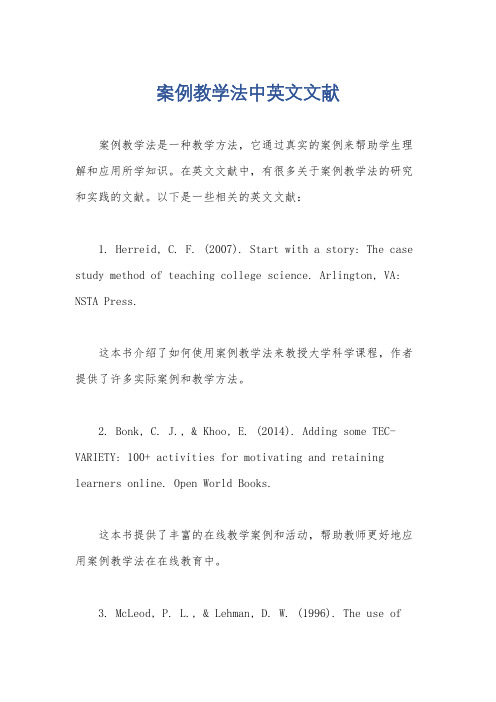
案例教学法中英文文献案例教学法是一种教学方法,它通过真实的案例来帮助学生理解和应用所学知识。
在英文文献中,有很多关于案例教学法的研究和实践的文献。
以下是一些相关的英文文献:1. Herreid, C. F. (2007). Start with a story: The case study method of teaching college science. Arlington, VA: NSTA Press.这本书介绍了如何使用案例教学法来教授大学科学课程,作者提供了许多实际案例和教学方法。
2. Bonk, C. J., & Khoo, E. (2014). Adding some TEC-VARIETY: 100+ activities for motivating and retaining learners online. Open World Books.这本书提供了丰富的在线教学案例和活动,帮助教师更好地应用案例教学法在在线教育中。
3. McLeod, P. L., & Lehman, D. W. (1996). The use ofcase studies in management education: An exploratory study. Journal of Management Education, 20(2), 146-160.这篇文章探讨了案例教学法在管理教育中的应用,作者通过实证研究分析了案例教学法对学生学习成效的影响。
4. Flick, L. B. (2008). The power of case-based reasoning: A review. Journal of Nursing Education, 47(10), 433-436.这篇文章从护理教育的角度探讨了案例教学法的重要性和效果,作者总结了案例教学法在护理教育中的应用和优势。
施工组织设计英文参考文献
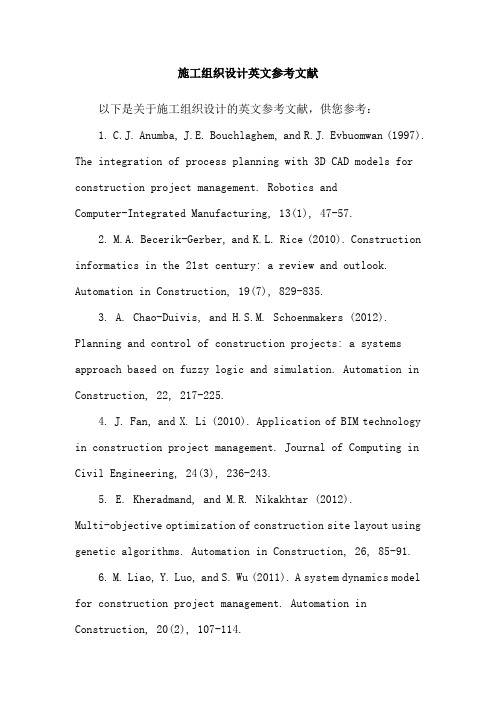
施工组织设计英文参考文献以下是关于施工组织设计的英文参考文献,供您参考:1. C.J. Anumba, J.E. Bouchlaghem, and R.J. Evbuomwan (1997). The integration of process planning with 3D CAD models for construction project management. Robotics andComputer-Integrated Manufacturing, 13(1), 47-57.2. M.A. Becerik-Gerber, and K.L. Rice (2010). Construction informatics in the 21st century: a review and outlook. Automation in Construction, 19(7), 829-835.3. A. Chao-Duivis, and H.S.M. Schoenmakers (2012). Planning and control of construction projects: a systems approach based on fuzzy logic and simulation. Automation in Construction, 22, 217-225.4. J. Fan, and X. Li (2010). Application of BIM technology in construction project management. Journal of Computing in Civil Engineering, 24(3), 236-243.5. E. Kheradmand, and M.R. Nikakhtar (2012).Multi-objective optimization of construction site layout using genetic algorithms. Automation in Construction, 26, 85-91.6. M. Liao, Y. Luo, and S. Wu (2011). A system dynamics model for construction project management. Automation in Construction, 20(2), 107-114.7. G. Shen, and J. Liu (2004). Integrating case-based reasoning and rule-based reasoning for construction project management decision support. Automation in Construction, 13(1), 11-23.8. T. Tezel, and I. Aziz (2008). Building information modeling (BIM) adoption and implementation for architectural practices. Structural Survey, 26(1), 7-25.9. J. Wang, Y. Wang, and X. Zhang (2010). Construction project management using building information modeling (BIM) in China. Proceedings of the 2010 International Conference on Construction & Real Estate Management, 924-928.10. L. Yi, and L. Chan (2009). A fuzzy set approach for construction project risk assessment and control. Automation in Construction, 18(6), 731-736.以上文献涵盖了施工组织设计中的多个方面,包括计划与控制、BIM技术应用、风险评估与控制等。
顾客服务英语词汇
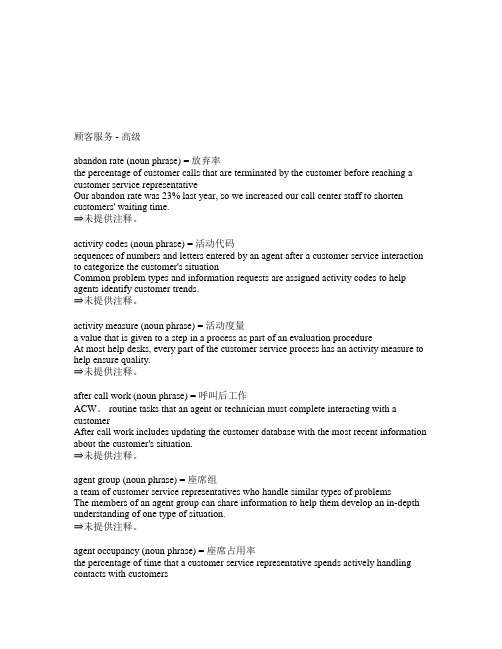
顾客服务 - 高级abandon rate (noun phrase) = 放弃率the percentage of customer calls that are terminated by the customer before reaching a customer service representativeOur abandon rate was 23% last year, so we increased our call center staff to shorten customers' waiting time.⇒未提供注释。
activity codes (noun phrase) = 活动代码sequences of numbers and letters entered by an agent after a customer service interaction to categorize the customer's situationCommon problem types and information requests are assigned activity codes to help agents identify customer trends.⇒未提供注释。
activity measure (noun phrase) = 活动度量a value that is given to a step in a process as part of an evaluation procedureAt most help desks, every part of the customer service process has an activity measure to help ensure quality.⇒未提供注释。
after call work (noun phrase) = 呼叫后工作ACW。
- 1、下载文档前请自行甄别文档内容的完整性,平台不提供额外的编辑、内容补充、找答案等附加服务。
- 2、"仅部分预览"的文档,不可在线预览部分如存在完整性等问题,可反馈申请退款(可完整预览的文档不适用该条件!)。
- 3、如文档侵犯您的权益,请联系客服反馈,我们会尽快为您处理(人工客服工作时间:9:00-18:30)。
hierarchical MEMS synthesis and optimization architecture, integrating an object-oriented data structure with SUGAR and two levels of optimization: global genetic algorithms (GA) and local gradient-based refinement. In this previous research, it was noted that the MOGA approach needed a means for automating the starting populations for the genetic algorithm that would enable a larger sampling of the solution space of MEMS designs. The general lack of design tools for the initial stages of the MEMS design process and the need to select better starting cases for synthesis tools that utilize genetic algorithms motivated the development of case-based reasoning capabilities for MEMS synthesis. Case-based reasoning tools utilize human knowledge from past design cases to guide human designers and computer-aided design (CAD) programs towards better design concepts. This paper focuses on the initial stages of case-based reasoning: case representation and retrieval, as these are the most crucial steps of the process. Information retrieved from a case-based system will only be as good as the knowledge that is initially represented and stored. MEMS resonant structures are used for the development of an initial system. 2. BACKGROUND 2.1 Case-based Reasoning Cased-based Reasoning (CBR) utilizes knowledge from a past situation to help deal with the complexities of a current problem. The field of CBR involves the indexing of information and the use of domain knowledge to improve search. CBR often works with a smaller hand-tailored collection of data where cases are structured according to domain-specific rules. Indexing and knowledge representation are the two initial and most important stages of CBR, determining the ultimate performance of a CBR engine. The case-based reasoning cycle has many variations depending on the application, but at a high level, CBR can be described by the following steps [6]: 1. Retrieve the most similar cases from memory 2. Reuse the retrieved cases and attempt to solve the problem at hand 3. Revise the proposed solution (if necessary) 4. Retain the new solution in the case memory for future use Retrieval is performed by matching the current problem to one or more similar cases in the case base. The most commonly used algorithms for case retrieval are nearest neighbor, induction, knowledge-guided induction, and template retrieval. These retrieval methods are often used alone or in combination with other strategies to form hybrid retrieval algorithms. The retrieved cases from the case base are then reused and tested to see how closely they fit the current design problem. If necessary, the retrieved cases are revised and modified for the current situation. From this, new cases are obtained, and, if the new cases are worthy of being retained, they can be added to the case library for future use.
Alice M. Agogino Department of Mechanical Engineering University of California at Berkeley, CA 94720 USA agogino@
ABSTRACT Although Micro-Electro-Mechanical Systems (MEMS) are forming the basis for a rapidly growing industry and fields of research, many MEMS designers still rely on backof-the-envelope calculations due to a lack of efficient computer-aided design (CAD) tools that can assist with the initial stages of design exploration. This paper introduces case-based reasoning (CBR) techniques to the design of MEMS, as part of a larger MEMS synthesis framework currently under development at UC Berkeley. Having the ability to draw upon past design knowledge is advantageous to the MEMS designer, allowing reuse and modification of previous successful designs to help deal with the complexities of a new design problem. CBR utilizes past successful MEMS designs and sub-assemblies as building blocks stored in an indexed library. Reasoning tools find cases in the library with solved problems similar to the current design problem in order to propose promising conceptual designs. This paper discusses case representation and case library design as well as the results of case retrieval studies, focusing on MEMS resonant structures. The paper recommends strategies for integrating the MEMS case library with evolutionary computation when parameter optimization over the retrieved conceptual designs is not sufficient or there are gaps of knowledge in the case library. Keywords: MEMS, Case-based Reasoning, Knowledge Representation, Knowledge System 1. INTRODUCTION Micro-Electro-Mechanical Systems (MEMS) are known as micro-machines or micro-scale mechanical devices with elements made with technology adapted from Integrated Circuits (IC). MEMS range from simple beams and electrostatic gaps to higher level sensors and actuators. Today, MEMS goes beyond basic electrical and mechanical
